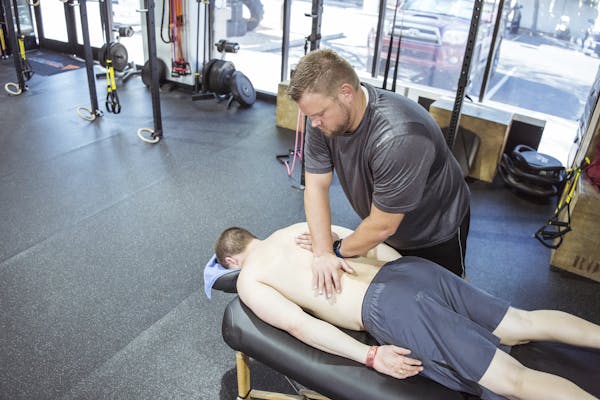
Do you have back pain or sciatica pain? You’re not alone! According to the World Health Organization, low back pain is so prevalent that up to 70% of us experience it at least once in our lifetime. For many of us, this pain becomes a chronic issue.
If you’re one of the millions of Americans struggling with signs and symptoms of sciatica or low back pain, we encourage you to set up an initial physical therapy appointment so we can get to the bottom of your dysfunction.
WHAT IS SCIATICA?
In your lumbar spine (lower back), you have two large nerves exiting on the right and left sides of your spinal column. These nerves, called the sciatic nerves, are the largest in your body and provide motor and sensory input to your legs. Several different nerve roots join together to form the sciatic nerves, which then divide and branch as they travel into the legs.
With sciatica, something irritates and compresses one of these nerves near the spine, leading to inflammation and tissue damage (along with a variety of symptoms, which we’ll discuss shortly). Sciatica can also be referred to as lumbar radiculopathy (with radiculopathy being a general term to describe spinal nerve impingement).
What’s compressing the sciatic nerve in the first place? Often it’s an injured spinal disc. When a disc ruptures and leaks (herniates) or protrudes out of place (bulges), it can press on the nearby nerve. This may happen due to wear and tear, acute trauma, or chronic repetitive stress on the disc.
The presence of another underlying condition can cause compression of the sciatic nerve as well, including:
- Degenerative disc disease: progressive thinning and breaking down of the spinal discs due to age-related wear and tear
- Stenosis: progressive narrowing of the spaces through which the spinal cord and nerves travel
- Osteoarthritis: inflammation of spinal joints, which also leads to joint space narrowing
These conditions can lead to generalized low back pain with or without nerve impingement.
More rarely, sciatica can be caused by bony tumors. A more distal portion of the sciatic nerve can also be compressed by a muscle in the hip called the piriformis, in a similar yet unique condition aptly known as piriformis syndrome.
COMMON SYMPTOMS & RISK FACTORS OF SCIATICA AND OTHER TYPES OF LOW BACK PAIN
Though the sciatic nerves originate in the lower spine, it’s not uncommon for some people experiencing sciatica to have no back pain at all! Instead, their symptoms primarily follow the motor and sensory distribution pattern of the nerves as they travel into the right or left leg. Such symptoms may include:
Pain that radiates into the buttocks, back of the leg, and sometimes the foot (sciatica pain often feels sharp, numb, burning, stabbing or shooting)
- Numbness and tingling in the leg
- Weakness in the leg
- Decreased reflexes in the leg
Additional symptoms can include spinal muscle spasms and tenderness, back stiffness, decreased tolerance to exercise, and decreased range of motion in the hips. A person’s low back pain or sciatica pain may be worse first thing in the morning, or after prolonged bouts of sitting or standing.
People who are at a greater risk for sciatica include men between the ages of 30 and 50, people who stand or sit a lot, people with physically demanding occupations (e.g., nurses, first responders, construction workers, etc.), and people who have experienced some sort of physical trauma, such as an auto accident or sports accident. Even smoking, diabetes, and obesity are believed to increase a person’s risk of sciatica and low back pain, given their tendency to promote inflammation and stress in the body.
HOW PHYSICAL THERAPY CAN DIAGNOSE & MANAGE SCIATICA
Robust research has proven that physical therapy is effective for those who suffer from back pain or sciatica pain. It’s safe, cost-effective, drug-free, and non-invasive, and recommended by professional organizations including the Centers for Disease Control and Prevention (CDC). Physical therapy treatment can even reduce the need for pain medications and expensive imaging studies like MRIs and X-rays!
When a physical therapist works with you for relief from your sciatica pain, the main goal will be to reduce your symptoms and alleviate the pressure on the sciatic nerve so that your symptom relief is longer lasting. Additional goals will be to heal the injured tissues, reduce inflammation, improve core stability and strength, restore function, and ultimately get you on a sustainable exercise program to help you maintain your outcomes.
In order to achieve these objectives, your sciatica or low back pain plan of care may include:
- Manual therapy, including massage, Cupping or Myofascial Decompression, Functional and Kinetic Treatment and Rehab (FAKTR or Tool work) and spinal traction
- Non-invasive modalities, including cold laser therapy, electrical stimulation, diathermy, and therapeutic ultrasound
- Dry needling
- Therapeutic exercises, stretches, and evidence-based core stabilization protocols (this means scientific studies have been done to vet the exercises’ effectiveness)
Are you experiencing back pain or symptoms related to sciatica? In some states, patients are allowed direct access to physical therapists, meaning they don’t need a referral from their primary care physician. We encourage you to talk to us or your doctor about getting started with a physical therapy program. Get the best back and sciatica pain relief treatment. Contact us at Mesa, AZ center to learn more and get back to the healthy pain-free life you deserve.
